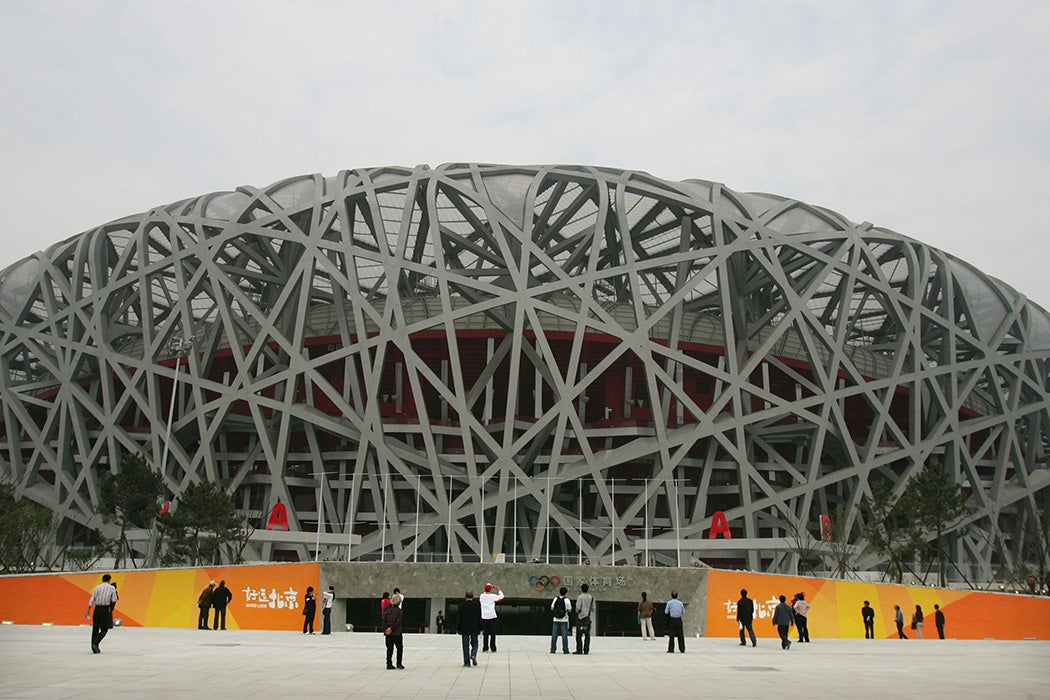While it may not be immediately obvious, architecture and the Olympic Games go hand in hand. Architecture creates the stage on which Olympians from around the world perform incredible physical feats. The stadia, the venues, and the host city serve as cultural and physical backdrops to this globally viewed event.
A close connection between architecture and the Olympic Games is actually central to the idea of the modern Olympics. The first modern Olympic Games was held in 1896 in Athens, Greece. As N. S. Thompson writes, from 1912 to 1948,
Olympic medals used to be awarded for architecture, literature, music, painting, and sculpture. Baron Pierre de Coubertin, founder of the modern games, envisaged an arts competition as integral; the idea of medals came later and was then only sporadically adopted.
While awarding medals in architecture never truly took hold, creating the built environment in which to present the games—especially in a televised and then social media-driven world—remains as important as ever.
The grandest spectacle in recent Olympic history is undoubtedly the 2008 Summer Olympics in Beijing. This was the first Olympic games held in China, celebrated through a stunner of an opening ceremony. The spectacle lasted more than four hours, with 15,000 musicians, dancers, and artists performing in the newly built Beijing National Stadium. Design historian Dr. Anne-Marie Broudehoux explains that the Olympics gave China an opportunity to rebrand itself to a global audience.
“The 2008 Olympic Games,” she writes,
provided a great impetus to accelerate the modernization of China’s capital city, initiated in the previous decades. City leaders quickly embraced the new mode of urban governance, using avant-garde architecture to update and re-brand China’s ancient socialist capital into a prosperous world metropolis.
The Beijing National Stadium, more commonly known as the Bird’s Nest, was designed by Swiss architectural firm Herzog & de Meuron. The well-known Chinese artist Ai Weiwei served as an artistic director on the project but later denounced his involvement. Ai left China in 2015 after harassment and a three-month detention by the Chinese government, and he “now criticizes other Olympic artists and architects for letting their talents be used to benefit political propaganda and economic power,” writes Broudehoux.
Many other well-known Beijing buildings were constructed adjacent to the Olympics during this period, including Rem Koolhaas’s CCTV Headquarters and Norman Foster’s Terminal 3 at Beijing Capital International Airport. The Beijing Summer Games is emblematic of how buildings associated with the Olympics, shown widely to a global audience, become representatives of the host nation by portraying a desired identity—in this case, forward-thinking and economically powerful.
Not all cities use the Olympics as a rebranding opportunity, however. In 2012, London had the honor of becoming the first city to host the Summer Olympics three times. But London was already a city with a widely known global identity. Tourist campaigns regularly proposed visiting Buckingham Palace to learn about the royal family, walking the Tower Bridge over the Thames River, and eating fish and chips in a traditional British pub. The brief from the London Olympic Delivery Authority required new venues, such as the Queen Elizabeth Olympic Park, to be considered with a “design legacy” in mind, writes architectural scholar Even Smith Wergeland. New construction was “supposed to benefit the local area when the Olympics [were] over.”
Weekly Newsletter
The Olympic Park became the architectural focal point of the Summer Games and home to the infamous ArcelorMittal Orbit. Part architecture and part sculpture, the soaring, weaving observation tower was designed by Indian British artist Anish Kapoor and Sri Lankan British designer Cecil Balmond.
The Orbit received a great deal of negative press at the time, but when considering its larger legacy, Thompson suggests that
in function, the helicoidal tower incorporating strange loops and Olympic rings is not too dissimilar from Gustave Eiffel’s contribution to the 1889 World’s Fair: a magnificent flagship mast that functions as a viewing platform for the whole Olympic Park.
It remains to be seen if the Orbit will become a beloved icon of London, as the Eiffel Tower is to Paris.
And the architecture of this year’s 2024 Summer Olympics in Paris? The city appears to be embracing its rich architectural history. The Eiffel Tower will serve as a backdrop to beach volleyball. The recently renovated Grand Palais will host fencing and taekwondo. Existing stadia, including the Stade de France, will also host sporting events. The one building missing out on the Olympic fun is Paris’s famous Notre-Dame de Paris. While repairs from the 2019 fire are almost complete, the cathedral isn’t expected to reopen until December 2024.







